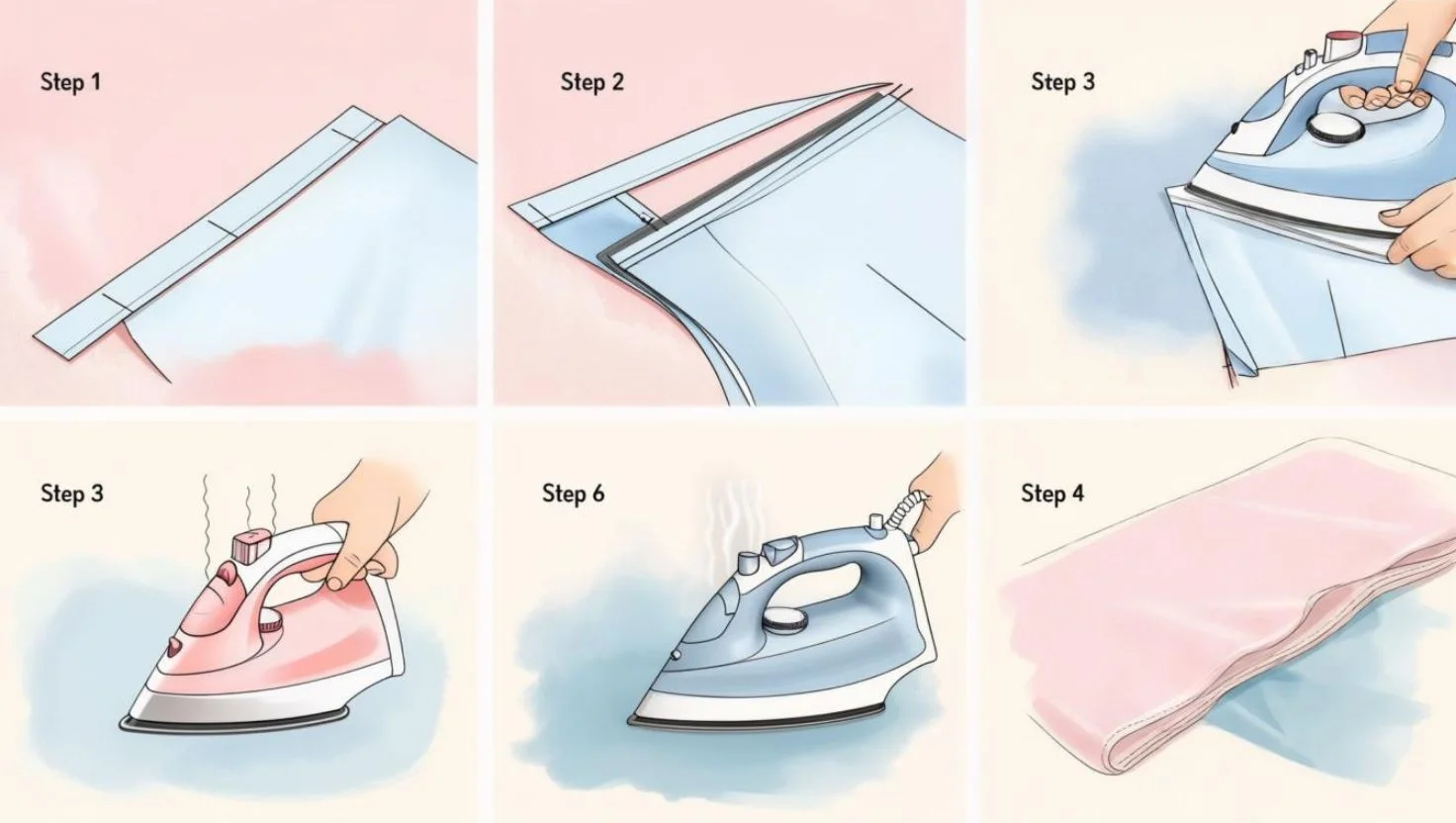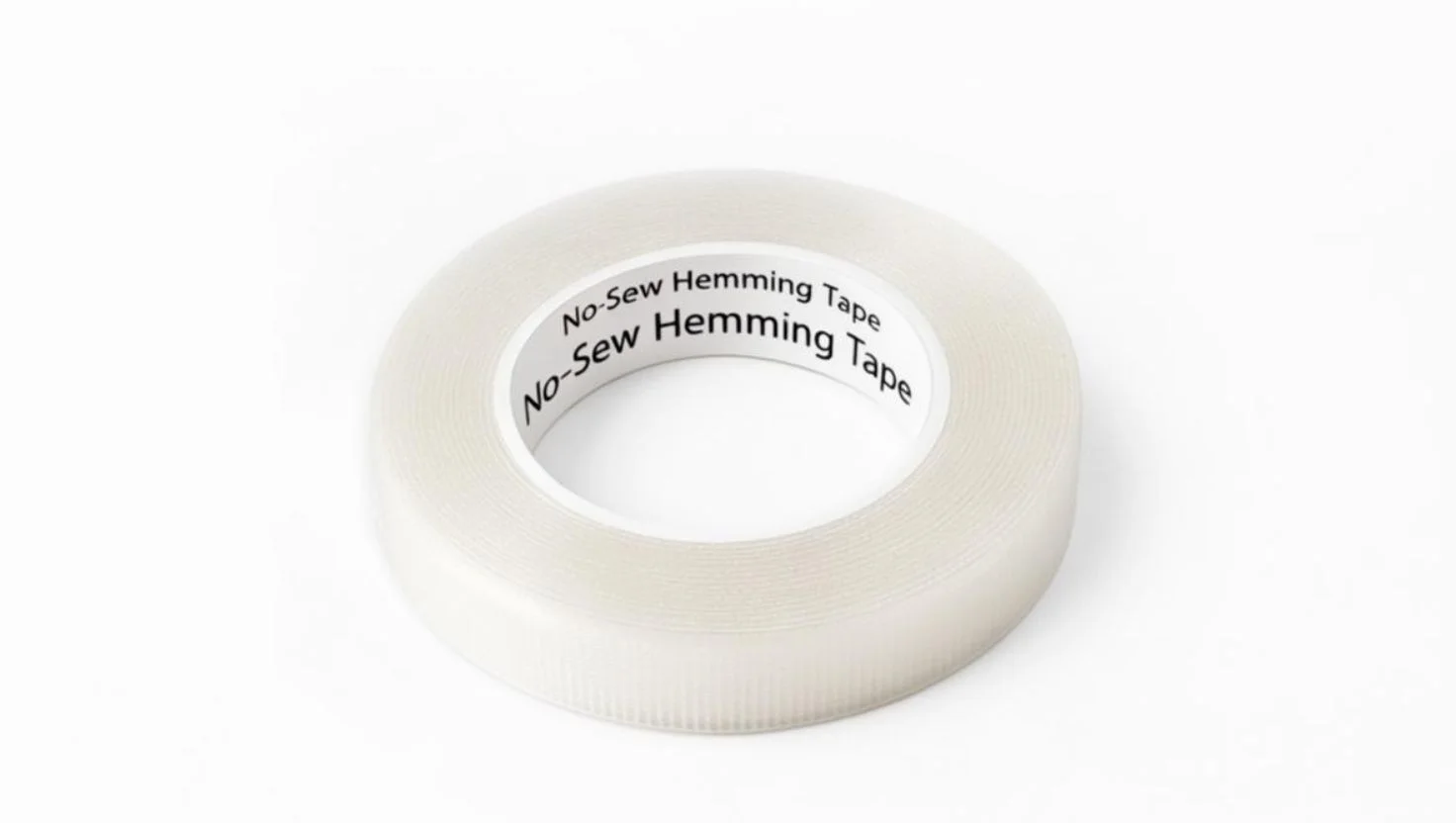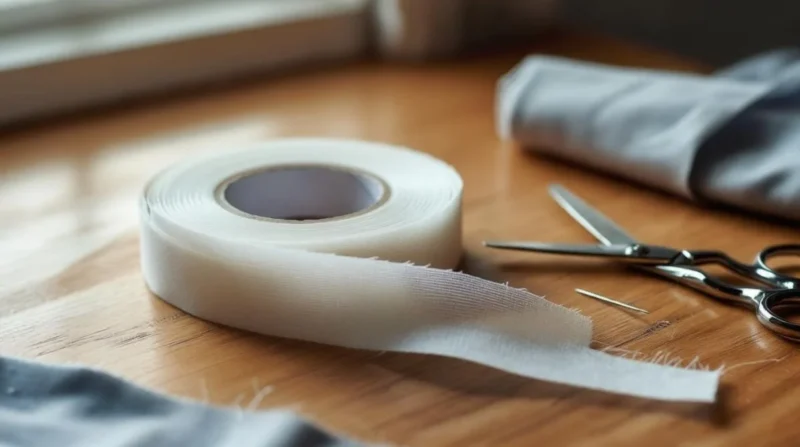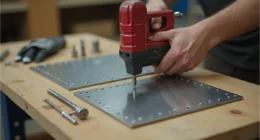Table of Contents
Hemming tape is a lifesaver when you need a fast wardrobe fix without threading a needle. It’s a double-sided adhesive strip that bonds fabric layers when heated by an iron or heat press. Whether your pants are too long or you’ve lost time to visit a tailor, hemming tape lets you hem clothes in minutes. Here’s how to make it work beautifully using simple everyday words.
Why Choose Hemming Tape?
- Speed & simplicity, no sewing skills needed, just an iron.
- No visible stitches maintain a clean, polished look.
- Portable, great for travel or last-minute fixes.
- Stays in place; most tapes hold through several washes when applied correctly.
However, not all fabrics work well avoid very stretchy, waterproof, or fuzzy materials like velvet, and always test first.
What You’ll Need?
Gather simple tools you likely already have:
- Hemming tape (choose stretch tape for knits, heavy-duty for denim).
- Sharp scissors.
- Iron and ironing board (or flat nonstick surface).
- Pressing cloth (cotton fabric or parchment paper).
- Ruler, chalk, or fabric marker.
Step-by-Step Guide
Step 1: Prep the Fabric
Wash and dry your clothing first. Fabric softeners can weaken the adhesive, so skip them. Iron the area flat to remove wrinkles and create a crisp crease. This makes it easy to fold the hem evenly.
Step 2: Measure & Cut the Tape
Turn your garment inside out. Adjust the hem to your preferred length, then secure it by either pinning it or pressing it gently to hold it in position. Measure the hem’s length, then cut the tape slightly longer (about ¼–½″) than your fold to avoid gaps. Sharp scissors give a clean edge, which avoids fraying.
Step 3: Insert the Tape
Slide the tape between the two layers of folded fabric, ensuring it’s fully inside and not sticking out. Work in sections if the hem is long or curved. For curved hems on knits or dresses, ease the fabric gently so it lies flat.
Step 4: Iron It On
- Set your iron to a dry setting appropriate for your fabric (wool or medium heat is common).
- Place a pressing cloth on top of the hem with tape to shield the fabric while pressing.
- Press firmly without sliding, hold the iron down for 10–15 seconds over each section.
- Let the area cool completely before checking.
- Work slowly, section by section. For heavy fabrics like denim or curtains, use high heat, heavy-duty tape. For delicate materials like silk or chiffon, apply low-heat hem tape and cover with a pressing cloth to protect the fabric during pressing.

Step 5: Check and Finish
Once cooled, gently tug the hem to test adhesion. If it lifts, reapply heat. Trust your iron applying enough pressure and heat is essential. For extra hold, you can stitch over the hem later, especially on heavy wear like uniforms or work pants.
Practical Tips & Common Issues
- Scrap fabric test: Always try on a small scrap to get settings right.
- Use pressing cloth: Avoid scorching or sticky residue, especially with synthetics.
- Segment work: Prevent puckering or uneven spots by taping in small sections.
- Right tape type: Choose stretch tape for knits; heavy duty for denim, lightweight for delicate.
- Test peel off vs permanent: Some tapes are temporary and easier to remove, read labels.
- Wash care: Turn garments inside out and use gentle cycles to extend adhesive life.
When It Works Best and When It Doesn’t?
- Ideal cases: Quick fixes on pants, skirts, curtains, tablecloths, travel gear, school uniforms, the tape makes life fast and easy.
- Not ideal: Highly elastic swimwear, satin evening wear, waterproof outdoor gear, or anything with piles or fuzzy surfaces these can prevent the bond from forming.
- Reddit users share: Hemming tape is a quick, affordable, and incredibly simple way to adjust or fix your clothing.
- Stitch Witchery: Simply lay the tape inside the memory hem and press it. It gives stability, making sewing smoother.
- But some caution: I hate that stuff. It’s strange-looking and actually not permanent. You’d be better off hiring a seamstress.
Pro-Level Tips
- Temporary vs permanent: Some tapes are meant to be removed (e.g., Scotch Removable Fabric Tape), others are permanent.
- Perfect for resizing: Great when switching between flats or heels, no commitment.
- Shipping-friendly: Many tailors use it for base layers before final stitching.
- Blend with stitch: For durability, sew a guiding stitch after taping to secure everything.
- Press memory hem first: Pre-press the hem fold first: Ironing it beforehand helps the tape stick better and gives a cleaner, more polished finish.

Quick Fix Solutions: 5 Best Hemming Tapes to Try in 2025
- Heat & Bond Hem Tape: A strong, double-sided adhesive perfect for both heavy and light fabrics; ideal for curtains, pants, and quick home repairs.
- Dritz Stitch Witchery: One of the most trusted hemming tapes; melts easily with heat and provides a permanent bond for garments and crafts.
- Scotch Removable Fabric Tape: Great for temporary fixes on clothes, perfect for costumes or last-minute outfit adjustments without damage.
- Singer Heavy Duty Iron-On Hem Tape: Designed for thick materials like denim and upholstery; holds up well after multiple washes.
- Aleene’s Fabric Fusion Tape: A no-heat, peel-and-stick option that’s excellent for delicate or heat-sensitive fabrics and craft projects.
FAQ
Q1. Is hemming tape permanent?
Mostly yes, when applied properly, it can last many washes, though sewing is more durable.
Q2. Can you remove it?
Permanently fused tapes leave residue and may damage fabric; removable types are available for temporary use.
Q3. Will it ruin the delicate?
If you use proper tape and pressing cloth, it’s safe even on chiffon and silk but always test first.
Q4. How long does it last?
Expect it to last through everyday wear and washing. Overuse, incorrect mix-and-match materials, or insufficient heat may reduce lifespan.
Conclusion
Hemming tape is a quick, no-sew way to give clothes a new lease of life. Set the iron right, choose the correct tape for your fabric, use a pressing cloth, and press firmly in sections. For casual repairs or travel fixes, it’s fast and slick. For heavy wear or heavy fabrics, consider reinforcing them with a stitch. When used smartly, hemming tape makes tailoring easy, no tailor, no stress.









